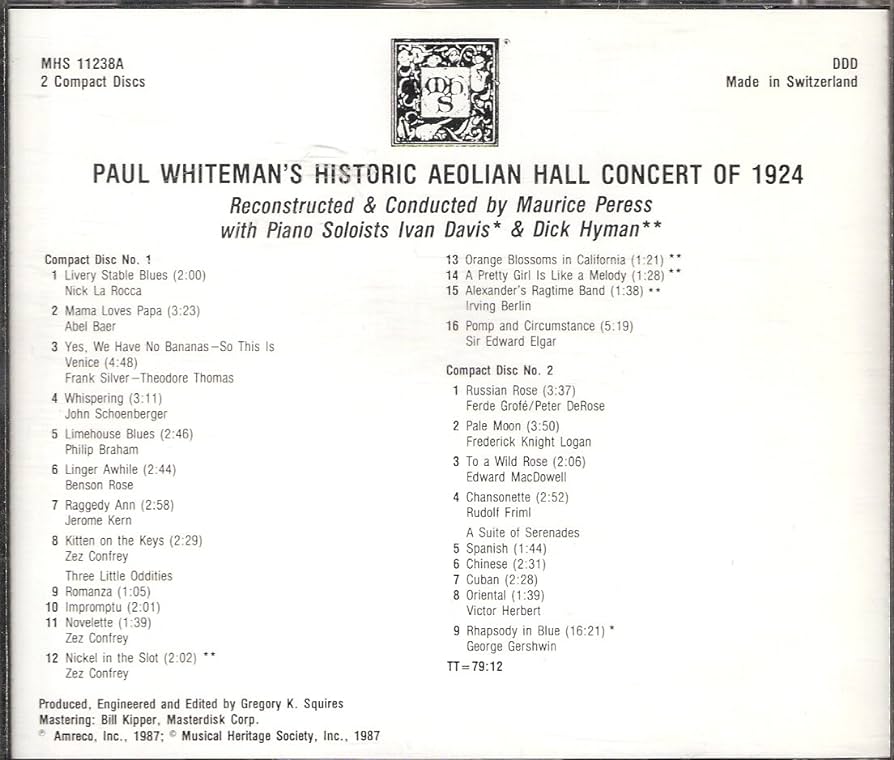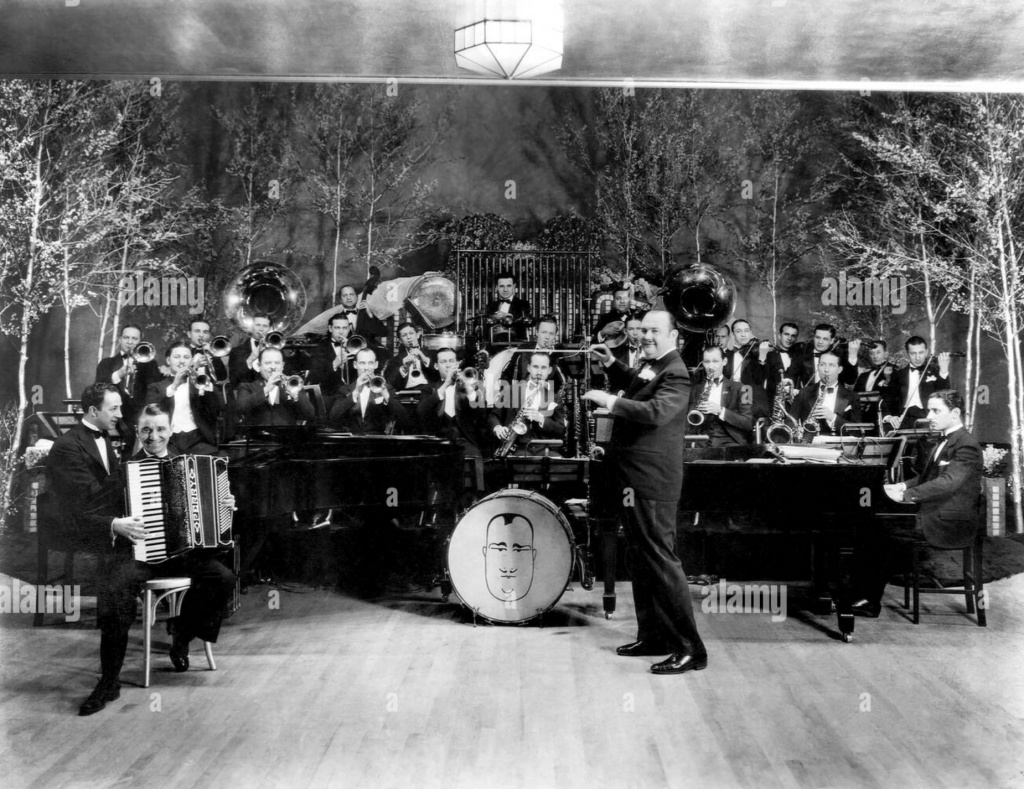My association with this American musical masterpiece is long —more than fifty (50) years. I hope that you will enjoy the result of my project (10/2023-2/2024) to create and record an electronic orchestral version of “Rhapsody In Blue” (“RiB,” henceforth) with video accompaniment.
Audio-Only Version of “Rhapsody In Blue“
My Mother, Margaret Morgensen Owen played RiB, and then as my piano-teacher, taught it to me when I was about eleven (11). It is in memory of my Mother and to her musical role in my life —that I dedicate this 2024 production and recording of this orchestral version.
To put time into perspective, RiB would have been about a third (1/3) as old when my Mother learned it as Beatles music is now in 2024. And, RiB was younger when I learned it —than those Beatles songs are now.
Arranging a piano-solo version of RiB may have been the first musical arrangement of my life. During one summer family trip I had the opportunity to compete in a campground talent-contest, but for performance-time’s sake, I needed a shorter entry. During the afternoon I arranged an abridged version of RiB that I played for the evening competition. I didn’t win. Many years later, I recorded that abridged version as part of the bespoke 2009 collection: KV Picks Seven (7).
My solo-piano version of RiB (2002) was published on Creative Minds’ Music’s Musings as Rhapsody in Blue , it was one of the few projects among what I call my “Collections” that I neglected to update when I converted ”Musings” to WordPress in 2009.
More than twenty (20) years ago, while I was still living in St. Louis before 1998, after creating my first “electronic orchestra” version of Samuel Barber’s “Adagio for Strings,” I conceived to eventually perform and record this rendition. I ordered a copy of the orchestral score from a music store there, now apparently closed. I didn’t examine the score until returning to AL and found two pages blank in the middle of the piece. Too much time had elapsed to ask anyone for replacement. Years then passed. Maybe ten years ago, I ordered a replacement score. It was also a “miniature” score like the first, except the second one was even smaller. I eventually made it into a PDF file that I viewed on my video monitor while I recorded tracks for this project. You can see several shots of the PDF on the monitor in the video.
There has been much written about RiB and its first performance on February 4, 1924. In what follows, I will will share a few facts that were surprising or notable to me —that I learned or re-learned while working on this project.
Before discussing historical facts of interest, the first big surprise to me —was finding while comparing the written scores, that the orchestral and piano-solo versions of RiB are not the same in form and are not even the same length. Maybe this is well-known, but I had not known this previously.
Gershwin had essentially “blown off” his promise to Paul Whiteman to compose a “serious” jazz-piano work to be performed by Whiteman’s Orchestra. The performance was planned to help lend “credibility” to the then-still-novel American “Jazz” idiom. However, not until Gershwin was reminded at Christmas 1923 by a published newspaper report of the pending concert —a spectacle in which Gershwin’s work would be featured, that he “got serious” about composing it.

The concert was planned to be extensive and to feature a number of contemporary “jazz” compositions and performers in addition to RiB, Paul Whiteman, and George Gershwin. It was considered novel and not yet chíc to present jazz-music in concert-hall settings. Whiteman commissioned his orchestra’s arranger, Ferde Grofé to score orchestral parts for the February performance. It is reported that at the moment of the concert, many or most of the piano parts were being improvised by Gershwin. It obviously turned out well, enough.
I had interest in Aeolian Hall where the performance occurred. At the time it was considered large, very elegant, and quite fine. It was host to many concerts of note in NYC for fifteen years, 1912-1927. Today, its building houses the SUNY College of Optometry —and its auditorium still exists.

For my tonal palate, I attempted to select instruments from my stable of instruments that were consistent with the number and type used in the Feb. 4, 1924 debut performance, which featured 24 musicians. There were only six (6) stringed instruments: violins, violas, cellos, string-bass, and banjo —not quite the lush symphonic version of full-orchestral strings that I often hear in contemporary recordings.
Choosing a particular synthesizer instrument to play each part provided a staggering number of options. Because of the huge number of nearly identically sounding results —my better judgement suggested making a/any choice and then proceeding deliberately and with vigor. I think of it being like being a painter who finds it difficult to begin painting because he has many tubes of paint —and, he can’t decide which one to use to start his new painting.
The featured piano is Synthogy’s Ivory American D (Steinway) virtual instrument. It is part of their “Ivory II” Collection. Synthogy has a new piano they call “Ivory III” that has caught my eye. We may be hearing it soon…
My number-one “go-to” instrument/synthesizer for project-strings has been “Synful Orchestra” (SO) for more than ten years. Long ago I evaluated studio-intruments’ string-sounds and their programmability. I chose SO.
For other, non-stringed orchestral instruments, and because I am most familiar with it, I began assigning instruments to my Kurzweil PC3K88 (PC3K) as they were used in the score from top to bottom: clarinets, trumpets, trombones, etc. —each of the scored instruments. Each instrument gets it’s own “channel” with separate volume and expression and separate from other instruments.
I found it amusing to see “Accordion” referenced as one the instruments used in the initial performance of RiB. There is no Accordion part in the score. I discovered that the accordion player was an accessory of Whiteman’s Orchestra —and composed his own accordion part, derived from other parts of the score.
I was also surprised to discover that “Banjo” is one of the instruments for which Grofé wrote a part. Banjos are loud, but truthfully I had never previously noticed a banjo part in any of the recordings I have heard, to date. There are several places in my recording that you may hear it. In fact, the accompanying video has a banjo reference while the banjo is playing —not the exact place in the score, but the banjo is playing, nonetheless. Maybe you will see and hear it…
The PC3K has the ability to simultaneously play sixteen (16) different solo instrument parts (channels). Early in my work, I began running out of channels and moved the French Horns from the PC3K to SO.
After recording all of the instrumental parts, I moved the 1st Alto Saxophone from the PC3K to my Yamaha Montage (Montage). The Montage and Korg Kronos (Kronos) both provide synthesizer capabilities that I could easily have used —but didn’t, this time…
I played/recorded all of the parts sitting on my height-adjustable stool in front of the Kronos. You will see this in the video. I have a remote bluetooth computer number-pad that I place on the Kronos, and that allows me to start and stop recording/playback and otherwise operate the “recorder transport” without having to reach over to the computer.
Software tools I used to produce the video:
- MOTU Digital Performer to record and edit audio,
- ProjectMilkSyphon and SyphonRecorder to produce and record the “psychedelic” synchronized visuals,
- QuickTime to quickly trim videos and check them after initial edits,
- FotoMagico to build introductory titling, credits, and ending graphics,
- Blender 3D’s video-sequencer to combine and arrange photos, audio, and video-clips, install transitions, and render the final video output in various formats,
- MacOS command-line terminal commands including ffmpeg to change the size and format of videos. For example, I must routinely change: .mov to .mp4 to .m4v, and produce both HD (1920×1080) and 960×540, the very useful size that I call “quarter HD.”
I kept extensive, likely excessive project notes for the duration of this project. I exported these notes as a PDF file and have included a link to, below. The earliest note is dated Oct. 30, 2023. The notes in the PDF are raw and mostly unedited. Much is included —links to some of the historical information mentioned in the text above, also included are items like the step-by-step procedure I used to record and monitor each track and then record the next one. There is a bunch of other material: Unchecked checklist-items, references to additional material about RiB, fonts I was considering for use with some of the graphics, and more…
RIB Project Notes (PDF format).

Leave a Reply